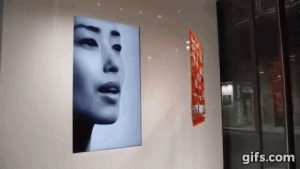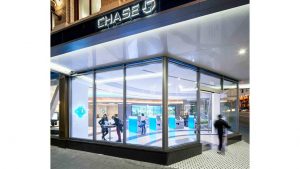We are in the early days of a tectonic shift in retail. Consumers are harder than ever to understand. The role of the store is in flux, and old reliable metrics aren't telling us the whole story. What hasn’t changed and what I believe will not change – is that moment when we capture the customer's attention, and they like what they see.
But how do we do that? How do we compete with the visual cacophony and create something that customers like? I believe blending proven, traditional visual merchandising with digital display, interactive and sensor techniques – dynamic visual merchandising, or dynamic VM for short – is the way to go.
Hermès' Ginza, Tokyo, store window / Source: YouTube; Hermès, Paris
In the 5 years I've been working with digital signage, the best example has to be the Hermès window in Ginza, Tokyo, pictured above. It perfectly leverages technology to do what a display is supposed to do: stop you in your tracks and impart something memorable about the product. The movement of the face and the windblown scarf (I still cannot figure out that magic, and I don't want to) show, in an elegant moment, the beauty of Hermès.
The concept of dynamic VM posits that the proven methodologies of traditional visual merchandising should embrace display, interactive and sensor technology. When digital techniques are designed into store environments and visual merchandising, and are executed at the same standards of detail, quality and brand communication that any display is held, we have the opportunity to create deeper and richer customer experiences and learn from the resulting data.
Chase Bank / Photography: Chuck Palmer, Columbus, Ohio
Advertisement
Digital can take a conversation that started on social media or on a brand’s website and continue it beyond the sale. It can bring new ideas, colors, patterns and products to life in ways that static imagery and displays simply cannot. It can be one- or two-way interactive, with passive sensors measuring and building databases. It can control lighting, imagery and messaging based on local conditions, which can all be centrally updated and monitored to assure timely messaging and integrity.
The possibilities are endless. Although you can do something, doesn’t mean you should do something. Unless the technology is fully integrated into the brand and presentation, wherever and however a customer interacts with you, then it is destined to disappoint.
Too often, we see screens, sensors and devices made to do a single thing, like play a video or be an “endless aisle,” plopped onto an endcap, wall or near an escalator. (I would expect many of the readers of VMSD know what I’m talking about.) You’re in a store, and you pause and say to yourself, “Seriously? What is that thing supposed to do, and who thought that would be okay?” Or even worse, a screen is left black. I maintain a black screen is worse than an empty shelf.
Don’t get me wrong. For every three good-hearted failures (despite best intentions), there is a success story. Have you been to Times Square lately? A Sephora store? Rebecca Minkoff’s SoHo, New York, flagship, an AT&T or Verizon flagship? I hold these in high esteem because they strategically leverage the full potential of networked technology and digital screens beautifully, enhancing the customer’s experience with the brand. And, best of all, the tech is not always apparent.
Nintendo shop-in-shop, Toys “R” Us, Times Square, New York / Photography: Chuck Palmer, Columbus, Ohio
I was fortunate to work on two projects that stand out as good executions of digital. While at Fitch, I worked with Nintendo to build out a Wii shop-in-shop at the then-Times Square Toys “R” Us. It contained two nine-screen arrays on which customers could play a variety of games. The other, when I was on the client-side at JPMorgan Chase, was leading the digital signage network in our West Coast flagship on San Francisco’s Union Square, which contained an 18-screen array that acted as a beacon to passersby.
Advertisement
Chase Bank / Photography: Chuck Palmer, Columbus, Ohio
Digital signage and its technology cousins can be complicated and finicky. These are complex endeavors that involve many stakeholders. But when done thoughtfully and methodically, and with the right partners, digital can reap big rewards from customer attention, attitude and loyalty to sales lift.
Chuck Palmer is a retail strategist working at the convergence of consumer behavior, technology and innovation. He works with retailers and brands, agencies and vendors on ideal consumer experiences. He has worked with JPMorgan Chase, Airstream, Macy’s, Crate & Barrel, Nintendo and JohnRyan among others. Chuck is a regular contributor to industry publications and is often called on for expert opinions. Find him on social media @cxchuck and ConsumerXretail.com.
|
|
Be sure to check out Chuck’s International Retail Design Conference (IRDC) session, “Dynamic VM: A Practical Guide to Enhancing Visual Merchandising with Technology,” in the Digital Integration power track, 2 p.m., Thursday, Sept. 15, 2016, in Montreal. For more details about his session and others, visit irdconline.com. |


 Photo Gallery2 days ago
Photo Gallery2 days ago
 Headlines1 week ago
Headlines1 week ago
 Headlines2 weeks ago
Headlines2 weeks ago
 Sector Spotlight2 weeks ago
Sector Spotlight2 weeks ago
 Headlines1 week ago
Headlines1 week ago
 Headlines3 days ago
Headlines3 days ago
 Headlines1 week ago
Headlines1 week ago
 Designer Dozen7 days ago
Designer Dozen7 days ago





















